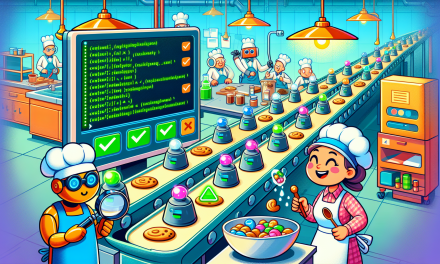Picture this: You’re standing in your kitchen, staring at a recipe for chocolate chip cookies, and suddenly you realise you’re already thinking like a computer scientist. You’ve broken the recipe into steps, identified patterns in the baking process, and even started troubleshooting when you discovered you’re out of brown sugar. Welcome to computational thinking—the mental toolkit that’s been hiding in plain sight throughout your daily life.
Computational thinking isn’t just about computers or coding. It’s a way of approaching problems that makes even the most complex challenges manageable. Think of it as your brain’s operating system for solving puzzles, whether you’re planning a holiday, organising your wardrobe, or figuring out why your wifi keeps cutting out during video calls.
The Four Superpowers of Computational Thinking
Every computational thinker has four trusty superpowers at their disposal, and you’ve probably been using them without even realising it. Let’s meet your secret weapons:
Decomposition is breaking big, scary problems into smaller, manageable chunks. When you’re planning to clean your entire house, you don’t tackle everything at once—you might start with one room, then focus on specific tasks like making beds or washing dishes.
Pattern recognition involves spotting similarities and trends. You’ve mastered this when you notice that traffic is always worse on rainy Monday mornings, or when you realise your younger sibling always gets cranky around 3 PM and needs a snack.
Abstraction means focusing on the important details while ignoring the irrelevant ones. When you give someone directions to your house, you don’t mention every single tree they’ll pass—you highlight the key landmarks and turns that actually matter.
Algorithm design is creating step-by-step instructions to solve problems. Every time you teach someone to make your famous pasta sauce or explain how to fold a fitted sheet, you’re designing an algorithm.
Route Planning: Your Daily Navigation Algorithm
Let’s start with something wonderfully familiar: getting from Point A to Point B. Whether you’re walking to school, cycling to meet friends, or driving to the shops, you’re running a sophisticated algorithm in your head.
First comes decomposition. You break your journey into stages: leave house, get to main road, navigate through town centre, arrive at destination. Then pattern recognition kicks in—you remember that the high street gets congested during lunch hours, or that there’s always construction work on Maple Avenue.
Abstraction helps you focus on what matters. You don’t plan your route around every single house number, but you do note important landmarks like the big oak tree or the bright yellow building. Finally, your algorithm emerges: “Walk to the corner, turn right at the post office, continue straight until you see the park, then turn left.”
The brilliant thing is, once you’ve created this mental algorithm, you can modify it based on new information. Construction blocking your usual path? Your algorithm adapts. Running late? It optimises for speed rather than scenic beauty.
Kitchen Chemistry: Cooking as Code
Every recipe is essentially a program, and every cook is a programmer—often a very creative one who isn’t afraid to debug on the fly. Think about making a simple sandwich. You’re decomposing the task (gather ingredients, prepare bread, assemble, serve), recognising patterns (mayonnaise always goes on both sides for even coverage), abstracting away unnecessary details (the exact brand of cheese doesn’t matter), and following an algorithm (bread first, then lettuce, then tomato, then cheese).
But here’s where cooking gets really interesting—it teaches you about conditional statements and problem-solving. “If the bread is stale, toast it first.” “If there’s no mayonnaise, try mustard instead.” “If the pan is too hot, reduce the heat and add a bit of oil.”
Even more advanced computational concepts appear in cooking. When you’re preparing a Sunday roast, you’re managing parallel processing—the potatoes need an hour, the vegetables need thirty minutes, and the gravy can be prepared while everything else is finishing. You’re optimising timing to ensure everything comes together perfectly.
The Great Wardrobe Sort: Data Organisation in Action
Organisation might not sound thrilling, but it’s actually a masterclass in computational thinking. When you tackle that overflowing wardrobe, you’re essentially becoming a data scientist.
Decomposition breaks the overwhelming task into categories: tops, bottoms, shoes, accessories. Pattern recognition helps you spot which clothes you actually wear (everything with the tags still on might need to go), and which combinations work well together. Abstraction lets you focus on key attributes—seasonality, frequency of use, colour coordination—while ignoring minor details like which specific store each item came from.
Your sorting algorithm might look something like: “Pick up item, determine category, check condition, decide keep/donate/repair, place in appropriate location.” The beauty is that once you’ve designed this system, you can apply it to organising anything—books, digital photos, even email inboxes.
Time Management: The Ultimate Scheduling Algorithm
Managing your time is perhaps the most sophisticated computational thinking challenge you face daily. Consider planning a typical Saturday: you need to do laundry, meet a friend for coffee, buy groceries, finish that history assignment, and still have time to relax.
Decomposition breaks your day into discrete tasks and estimates how long each will take. Pattern recognition helps you remember that laundry takes three hours total but only requires your attention for ten minutes at the beginning and end. Abstraction focuses on dependencies—you can’t meet your friend until you’ve showered, and you can’t shower until the laundry is at least started.
Your scheduling algorithm considers constraints (shop opening hours, friend’s availability) and optimises for efficiency. Maybe you start the laundry first, then work on the assignment while clothes wash, pop them in the dryer before heading out for coffee and groceries, and return home just as everything’s ready to fold.
Hands-On Challenge: Design Your Morning Routine Algorithm
Ready for some practical computational thinking? Let’s design the perfect morning routine using our four superpowers:
Step 1: Decomposition
List every single thing you do from waking up until leaving the house. Don’t skip anything—even checking your phone or making your bed counts. Aim for at least 15-20 individual tasks.
Step 2: Pattern Recognition
Look at your list and spot patterns. Which tasks always happen in the same order? Which ones depend on others being completed first? Are there things you do simultaneously?
Step 3: Abstraction
Identify the essential tasks versus the optional ones. What absolutely must happen for you to start your day successfully? What are just nice-to-haves when time permits?
Step 4: Algorithm Design
Create a step-by-step morning routine that maximises efficiency and minimises stress. Include timing estimates and decision points (“If running late, skip breakfast preparation and grab fruit instead”).
Test your algorithm for a week, then refine it based on what you discover. Congratulations—you’ve just designed, tested, and optimised your own personal program!
The Problem-Solving Mindset: Beyond the Obvious
What makes computational thinking truly powerful isn’t just the ability to break things down—it’s the mindset shift towards seeing problems as puzzles to be solved rather than obstacles to endure. When your bicycle chain comes off, computational thinking transforms frustration into curiosity. You decompose the problem (chain, gears, tension), recognise patterns (this happens when shifting gears too quickly), abstract the core issue (misalignment), and design a solution (reposition chain, adjust shifting technique).
This approach works for social problems too. Planning a surprise party becomes a project management exercise with dependent tasks, resource allocation, and risk assessment. Resolving a disagreement between friends involves decomposing the conflict, recognising underlying patterns in communication, abstracting the core concerns, and designing a step-by-step approach to resolution.
Building Your Computational Confidence
The remarkable thing about computational thinking is that you’re already doing it—you just might not have recognised it yet. Every time you troubleshoot why your phone battery drains quickly, organise a group outing, or figure out how to fit everything into your backpack, you’re flexing these mental muscles. The more you recognize and intentionally use computational thinking, the stronger and more confident you become—not just in coding, but in every aspect of your life.
Whether you’re planning a trip, solving kitchen surprises, or mediating a tricky group project, computational thinking helps you break big tasks into manageable steps, uncover hidden patterns, and design solutions. With each problem you tackle, you’re building a toolkit that will serve you in school, work, and everyday adventures.
Remember, you don’t have to be a programmer to think like a coder. These superpowers of decomposition, pattern recognition, abstraction, and algorithm design are already part of your brain’s repertoire. Next time you face a challenge, ask yourself: which of my computational thinking skills can I use right now?
Genius isn’t magic—it’s a way of thinking. And you already have everything you need to solve life’s puzzles, one step at a time.








